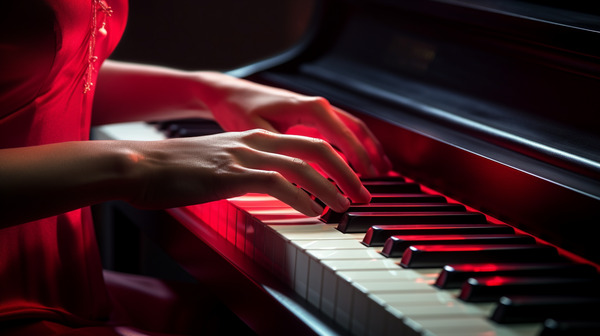Are you ready to learn how to play chords on your digital piano?
In this article, we'll guide you through the process of getting started with chords, understanding essential chord theory, and mastering basic chord shapes.
We'll also share techniques to help you improve your chord transitions and explore advanced chord progressions.
By the end, you'll have the skills and knowledge needed to confidently play a variety of chords on your digital piano.
Let's dive in and get started!
Getting Started With Chords on a Digital Piano
If you're new to playing chords on a digital piano, the first step is to familiarize yourself with the different types of chords and their fingerings. Chords are the foundation of music and learning them will greatly enhance your playing abilities.
Start by understanding the basic major and minor chords. Major chords have a happy and uplifting sound, while minor chords create a more somber and melancholic tone. Once you have mastered these, you can move on to more advanced chords like suspended, augmented, and diminished chords.
Each chord has its own unique finger placement on the keyboard, so it's important to practice and memorize the correct positions. Take your time to learn and practice each chord until you can effortlessly play them on your digital piano.

Essential Chord Theory for Digital Piano Players
Understanding the basic theory behind essential chords is crucial for digital piano players. By grasping the foundations of chord theory, you'll be able to construct and play a variety of chords confidently on your digital piano.
Chords are made up of three or more notes played simultaneously, and they provide the harmonic structure and foundation for many songs. The most common chords you'll encounter are major, minor, and dominant chords.
Major chords have a happy and uplifting sound, while minor chords create a more melancholic and somber feel. Dominant chords add tension and a sense of resolution to a piece of music.
Learning how to build and play these essential chords will greatly enhance your ability to play a wide range of songs on your digital piano.
Mastering Basic Chord Shapes on a Digital Piano
Mastering the basic shapes of chords on a digital piano can greatly improve your playing ability. By familiarizing yourself with these fundamental chord shapes, you will be able to play a wide range of songs and progressions more easily.
Start by learning the major and minor chords in all keys. Practice moving between these chords smoothly and accurately, paying attention to correct hand and finger positioning.
As you become more comfortable with these basic shapes, you can then move on to more complex chords such as sevenths, suspended chords, and inversions. Remember to practice regularly and gradually increase the difficulty of the chord progressions you play.
With time and dedication, you will develop a strong foundation in chord shapes, enhancing your overall piano playing skills.
Techniques to Improve Chord Transitions on a Digital Piano
To improve your chord transitions on a digital piano, focus on practicing smooth and accurate hand movements between different shapes.
Start by placing your fingers on the correct keys for each chord shape. As you play the first chord, pay attention to the position and movement of your fingers. Keep your hand relaxed and avoid unnecessary tension.

When it's time to transition to the next chord, lift your fingers off the keys and move them swiftly to the new positions. Aim for a seamless transition, without any pauses or hesitations.
Practice this movement repeatedly, gradually increasing the speed and accuracy of your transitions. Remember to start slow and gradually build up your speed. With consistent practice, your chord transitions will become more fluid and effortless.
Advanced Chord Progressions for Digital Piano Players
As you progress on the digital piano, you'll come across more complex chord progressions that challenge your skills and creativity. These advanced chord progressions add depth and complexity to your playing, allowing you to create beautiful and intricate music.
One example of an advanced chord progression is the ii-V-I progression, commonly used in jazz music. This progression involves playing the second, fifth, and first chords of a major scale in sequence.
Another challenging chord progression is the circle of fifths, which involves moving through a series of chords that are a fifth apart. These advanced chord progressions require precision and dexterity in your fingers, as well as an understanding of music theory.
Take your time to practice and master these progressions, and soon you'll be able to impress others with your skillful playing.
What Is the Best Digital Piano for Beginners to Learn Chords On?
The best digital piano for beginners to learn chords on is one with weighted keys and a variety of sound options. It should also have a user-friendly interface and built-in tutorials to help you learn chord progressions.
How Long Does It Typically Take to Become Proficient at Playing Chords on a Digital Piano?
It typically takes time and practice to become proficient at playing chords on a digital piano. You need to consistently work on your technique and build muscle memory.

It's important to dedicate regular practice sessions to chords, focusing on the correct finger placement and hand positioning. This will help you develop the necessary strength and coordination to play chords smoothly and accurately.
In addition to practicing chords individually, it's also beneficial to practice transitioning between different chords. This will improve your ability to quickly switch between chords in a song or piece of music.
Remember to start with simple chords and gradually progress to more complex ones as you become more comfortable. Don't get discouraged if you make mistakes or find certain chords challenging at first. With patience and persistence, you'll gradually improve and become more proficient at playing chords on a digital piano.
Are There Any Shortcuts or Tricks to Help With Learning and Memorizing Chord Shapes on a Digital Piano?
There are no shortcuts or tricks to help with learning and memorizing chord shapes on a digital piano. It takes practice and dedication to become proficient.
Keep practicing and you'll get there!
Can I Use the Same Chord Shapes and Progressions on a Digital Piano as I Would on an Acoustic Piano?
Yes, you can use the same chord shapes and progressions on a digital piano as you would on an acoustic piano.
The layout and functionality may be slightly different, but the principles remain the same.
Are There Any Specific Exercises or Drills That Can Help Me Improve My Chord Transitions on a Digital Piano?
To improve your chord transitions on a digital piano, try exercises like playing simple chord progressions in different keys. Gradually increase the tempo as you practice regularly to build muscle memory and improve your coordination.
Conclusion
So there you have it! You've learned the basics of playing chords on a digital piano. By understanding chord theory, mastering basic shapes, and practicing techniques for smooth transitions, you'll be well on your way to becoming a skilled digital piano player.
Don't forget to challenge yourself with advanced chord progressions to further enhance your skills. Keep practicing and exploring different chord combinations, and soon enough, you'll be playing beautiful music on your digital piano!
Harlan Kilstein began playing piano during covid with no piano background at all. He taught himself how to play learning what to do and what not to do.
Today he's an advanced intermediate player and can help you grow in your skills because he learned all this on his own.








